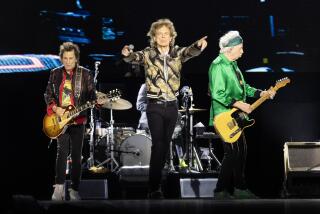Rock ‘n’ Roll, Now Age 30, Turns from Fad to Legacy
- Share via
For those who didn’t notice, rock ‘n’ roll recently turned 30. What was once a minor musical disturbance has now been ratified by Congress as a genuine menace to society. Progress of a sort, I guess, given the nature of the music. I remember when the rallying cry was, “Don’t trust anyone over 30.” I knew they meant me, so I’ve been keeping an eye on this music (from a safe distance, of course) ever since. I noticed that Rock ‘n’ roll quickly became a unifying force for alienated kids--something my generation never had, since we were conditioned to accept our parents’ moon-June music without question.
In the beginning, rock ‘n’ roll was a music of very little precisions, but a lot of passion. These musical barbarians bypassed the stuffy, civilized music establishment and just went one-on-one with the listener: “Be Bop a Lula,” “Little Deuce Coupe,” “Motorcycle Mama,” “Smokin’ in the Boys’ Room”--and forget about “moon” and “June,” the hot rhyme for rockers was “fire” and “desire.”
Early rock was city music--right off the streets. But it had no prejudice at all, and it became a marvelous musical melting pot for regional and ethnic styles that had never been widely heard. To me, the crowning achievement of this process came in 1957 when the Everly Brothers’ “Wake Up Little Susie” became a national hit. It was pure Appalachian mountain harmony.
My generation of city kids scorned this type of thing. We thought the worst name you could be called was “hillbilly” or “Okie.” Another example was Little Eva’s 1962 hit “Loco-Motion.” It was a joyous gem of a record in which the lyric described a dance, but the music was pure black gospel. My generation of whites simply wouldn’t listen to anything like that. In the McCarthy era, conformity meant even musical conformity. (Don’t forget, there was something about folk music in those days that had a strong attraction for the House Un-American Activities Committee.) Since rock drew heavily from country music, black blues styles, and black gospel music, it needed a consumer group with less racial and regional prejudice than ours. By about 1956, teen-agers had had it up to here with all that conformity and they reacted with scandalous behavior--they became open-minded, nonjudgmental and unprejudiced.
But no sooner had this renegade music gotten started than the corporate music establishment began trying to stamp it out. By the early ‘60s (with its Presley having been booked elsewhere for a couple of years) they had nearly succeeded. But in 1964, echoes of Chuck Berry and Buddy Holly came back to us from across the Atlantic in the form of the Beatles and Rolling Stones.
You can bet there was much hand-wringing by parents when they saw that first TV close-up of a feverish Mick Jagger wrapping his rubber lips around “I Can’t Get No Satisfaction.” And such arrogant smiles on those sassy Beatles as they shook their hair at the girls and howled “Shake It Up, Baby!” I think the folks down at the PTA knew by then that this urgent music was going to shake their conformist society to its very foundations.
Rock ‘n’ roll has come a long way, and is not without its own sense of responsibility. Ironically, now that rock musicians are turning out anti-drug songs and humanitarian anthems that raise millions for the world’s hungry, Congress is quibbling about a fringe element of sleaze. What’s worse, their ladies’ auxiliary wants to label this stuff and thereby give it the highest possible profile. Does that make sense?
Thirty years ago rock ‘n’ roll was a fad. Now it’s a legacy. In the same way that Chuck Berry celebrated youth in 1956, so do Prince Bruce Springsteen, Echo and the Bunnymen, or the Hoodoo Gurus in 1986. As Bob Seger says, “All Chuck’s children are out there playing his licks.” Leave ‘em alone.
ELLEN GRIFFITH
Los Angeles
More to Read
The biggest entertainment stories
Get our big stories about Hollywood, film, television, music, arts, culture and more right in your inbox as soon as they publish.
You may occasionally receive promotional content from the Los Angeles Times.










